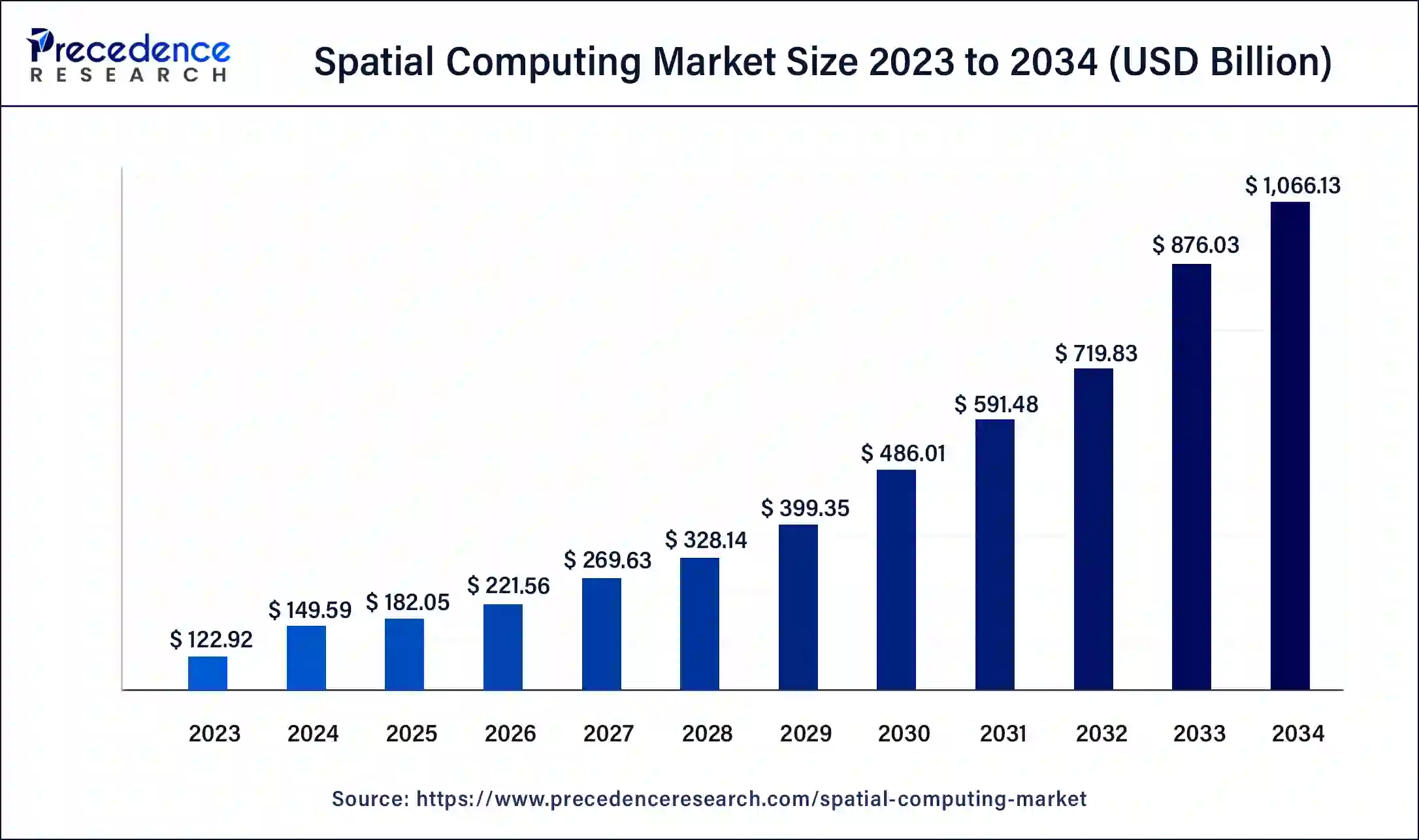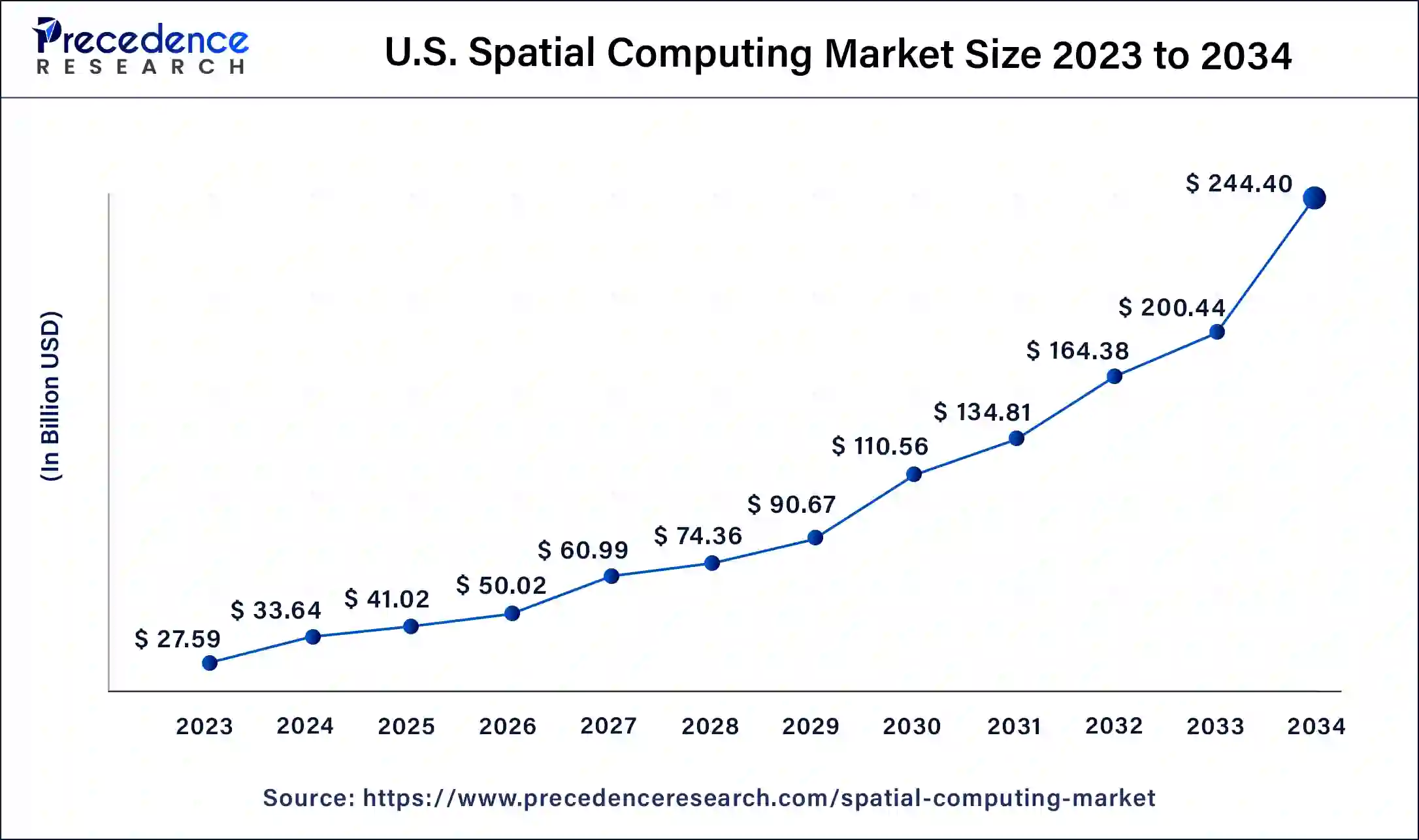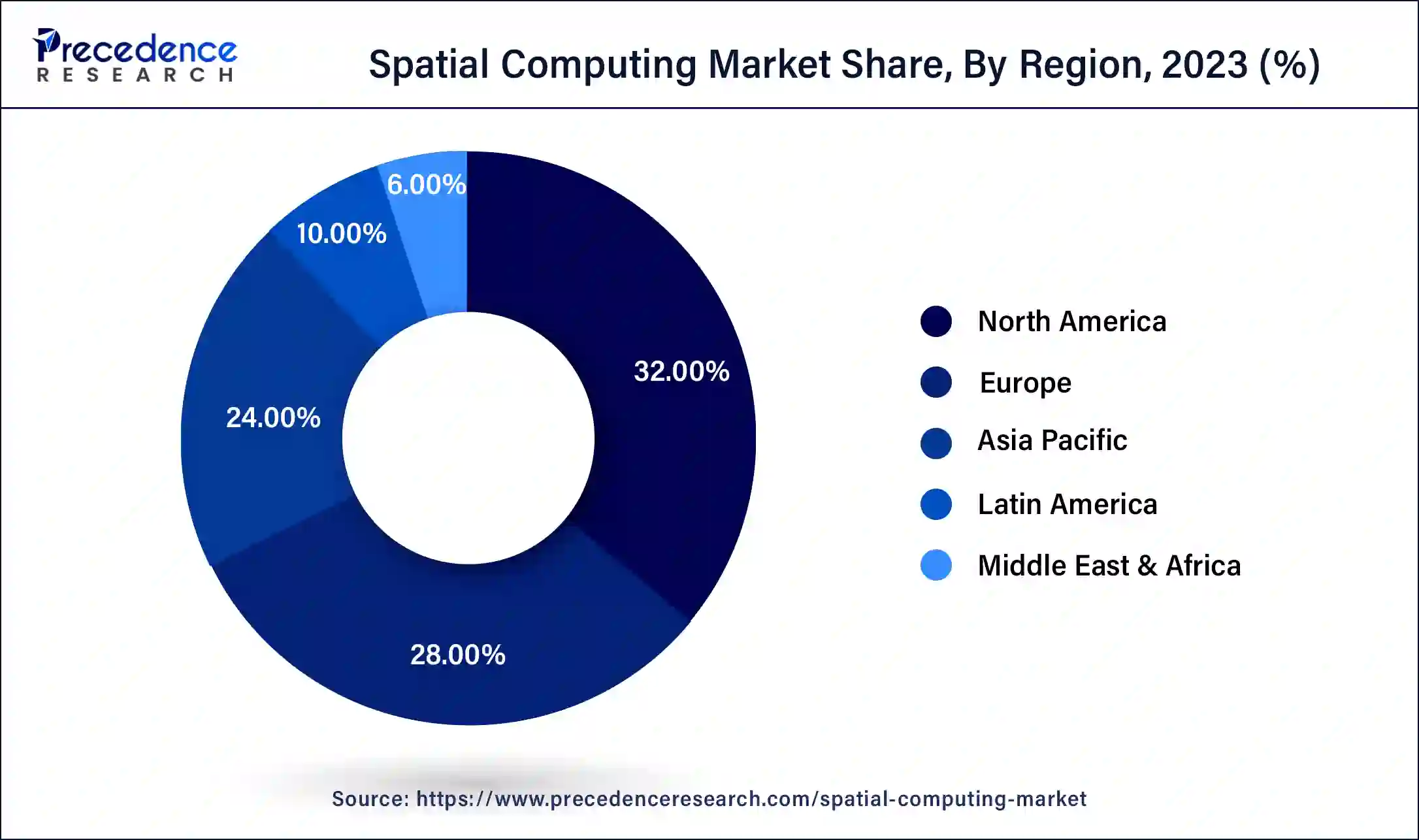January 2025
Spatial Computing Market (By Component: Software, Hardware, Services; By Technology: Augmented Reality, Virtual Reality, Mixed Reality, Artificial Intelligence, Digital Twins, Internet of Things, Others; By End User: Aerospace & Defense, Healthcare, Automotive, Gaming, Energy & Utilities, Consumer Electronics, Architecture, Engineering, & Construction, Government & Public Sector, Information Technology, Others) - Global Industry Analysis, Size, Share, Growth, Trends, Regional Outlook, and Forecast 2024-2034
The global spatial computing market size was USD 122.92 billion in 2023, calculated at USD 149.59 billion in 2024, and is expected to reach around USD 1,066.13 billion by 2034. The market is expanding at a solid CAGR of 21.7% over the forecast period 2024 to 2034. The North America spatial computing market size reached USD 39.33 billion in 2023.

The U.S. spatial computing market size was estimated at USD 27.59 billion in 2023 and is predicted to be worth around USD 244.40 billion by 2034, at a CAGR of 21.9% from 2024 to 2034.

North America held the largest share of 32% in 2023. The area is a major center for technical advancement, R&D, and the commercialization of spatial computing technology. Numerous industry-leading businesses and research facilities that propel market improvements are based in the region. Leading companies in the development of hardware, software, and platforms for spatial computing include Microsoft, Google, Apple, Facebook, and Magic Leap.
These developments have provided cutting-edge goods and experiences, which have propelled the market's expansion. Particularly in major hotspots like Silicon Valley, Seattle, and Greater Boston, the area has a thriving startup scene. Technology-focused startups have surfaced and gained momentum, introducing new concepts, advancements, and competition to the market. These startups frequently push the limits of these technology applications, developing novel uses and stimulating the market.

Asia Pacific is expected to grow at the highest CAGR of 22.2% during the forecast period. High smartphone penetration rates in countries like China and India create a favorable environment for mobile-based spatial computing applications. Mobile AR experiences and applications are becoming increasingly popular. This is expected to drive market growth in the region during the forecast period.
The spatial computing market refers to the use of digital technologies to process and interact with information in a three-dimensional space. It involves the integration of virtual or augmented elements into the physical world, creating an immersive and interactive environment. Spatial computing leverages technologies like augmented reality (AR), virtual reality (VR), and mixed reality (MR) to blend the digital and physical worlds, allowing users to engage with computer-generated content more naturally and intuitively.
| Report Coverage | Details |
| Growth Rate from 2024 to 2034 | CAGR of 21.7% |
| Global Market Size in 2023 | USD 122.92 Billion |
| Global Market Size in 2024 | USD 149.59 Billion |
| Global Market Size by 2034 | USD 1,066.13 Billion |
| U.S. Market Size in 2023 | USD 27.59 Billion |
| U.S. Market Size by 2034 | USD 244.40 Billion |
| Base Year | 2023 |
| Forecast Period | 2024 to 2034 |
| Segments Covered | By Component, By Technology, and By End User |
| Regions Covered | North America, Europe, Asia-Pacific, Latin America, and Middle East & Africa |
Growing demand for consumer electronics in the education sector
The usage of consumer gadgets in classrooms, such as tablets and laptops, is growing. Educational materials and apps for spatial computing can provide students with immersive learning opportunities. As a result, by 2030, the consumer electronics sector will account for around one-fifth of the market. Educational materials and apps for spatial computing can provide students with immersive learning opportunities. AR glasses like Google Glass, VR headsets like Oculus Rift and HTC Vive, and AR glasses like Microsoft HoloLens have all been released by consumer electronics firms. Innovation is driven by investment in creating hardware and applications for spatial computing, as well as by customer desire for more immersive and interactive experiences. Thus, this is expected to drive the spatial computing market’s growth over the forecast period.
Regulatory and ethical issues
Technologies for spatial computing employ cameras and sensors to gather and interpret environmental data about the user. Building user trust and resolving any privacy-related issues depend on ensuring the security and privacy of this data. Devices for spatial computing frequently gather information about users' interactions, actions, and surroundings. Images, videos, and sensor measurements are all included in this data. It is essential to safeguard consumers from unlawful monitoring and data breaches by guaranteeing the privacy of this data. As a result, ethical and legal issues provide significant barriers that may prevent the spatial computing market from expanding and being adopted.
Rising partnership
The increasing partnership in the industry is expected to offer a lucrative opportunity to the spatial computing market during the forecast period. For instance, in July 2022, NavVis, a German technology business that specializes in indoor mapping and navigation solutions for a range of sectors, and Magic Leap, Inc. partnered together. By working together, the two businesses want to enhance augmented reality (AR) applications in the industrial and automotive sectors by providing precise and in-depth 3D digital twin data.
The software segment is expected to grow at a rate of 21.1% over the forecast period. A key element of spatial computing is augmented reality (AR) software, which enables the overlay of digital data on the physical world. This covers apps for smart glasses, headsets, and mobile devices. Numerous industries, including retail, navigation, healthcare, and education, employ augmented reality software. Furthermore, users can explore realistic, computer-generated settings made possible by VR software.
Applications for virtual reality (VR) include training simulations, virtual meetings, and games and entertainment. The VR software industry is influenced by VR development platforms, VR gaming engines, and content production tools. Besides, the hardware segment is expected to grow at the fastest rate over the forecast period. It describes technological advancements that allow real-time interaction between the digital and physical worlds, resulting in immersive user experiences. The rise of the industry has been largely attributed to head-mounted displays, such as augmented reality glasses and virtual reality headsets.
By superimposing digital material over the actual world or by building a completely virtual environment, these gadgets provide consumers with immersive visual experiences. Beyond head-mounted displays (HMDs) and motion controllers, wearable technology may be integrated into the spatial computing ecosystem through smartwatches, fitness trackers, and even clothes with sensors built in. These gadgets can record users' biometric information, such as their bodily motions and pulse rate, giving computing applications more input and allowing more individualized experiences.
The Augmented Reality segment held the largest share of 22% in 2023. By superposed digital content such as text, photos, videos, or 3D objects—over the user's field of vision, augmented reality (AR) improves the physical world. AR glasses or mobile devices are usually used for this purpose. AR has been widely available to a large user base due to the growing uses of tablets and smartphones along with advanced sensors and cameras.
The growing popularity of mobile AR applications, including utility apps, games, and social media filters, is propelling the AR market's expansion. With specialized AR glasses, users can effortlessly superimpose digital material onto their field of vision for a hands-free, immersive AR experience. Lightweight and more aesthetically pleasing AR glasses have been developed as a result of technological advancements and miniaturization.
Leading companies in the industry, such as Google (Google Glass), Microsoft (HoloLens) and Apple (VisionPro), are making investments in AR glasses, which is driving the market's expansion. On the other hand, the mixed reality segment is expected to grow rapidly over the forecast period. Mixed reality has gained significant adoption in enterprise settings. Industries such as manufacturing, healthcare, and design use MR for applications like virtual product prototyping, remote assistance, and training simulations. Thereby, driving the spatial computing market growth.
The healthcare segment held the largest share of the spatial computing market in 2023. Healthcare practitioners can practice complex procedures and scenarios in a safe and controlled virtual environment because of spatial computing, which includes VR, AR and MR. This technology offers a variety of functions and advantages in the field of healthcare. Healthcare professionals may improve their skills and knowledge without endangering patient safety by using MR and VR simulations to provide training, patient examinations, and medicinal procedures.
Through the use of MR or AR headsets, CR scans and MRI images are examples of medical imaging data that surgeons can superimpose on a patient's body while operating, aiding in surgical planning and guidance. This technology allows surgeons to visualize patient-specific anatomical data in a 3D virtual environment. This enhances surgical results, lowers risks, and improves accuracy. Thus, this is expected to drive the segment expansion.
Segments Covered in the Report
By Component
By Technology
By End User
By Geography
For inquiries regarding discounts, bulk purchases, or customization requests, please contact us at sales@precedenceresearch.com
No cookie-cutter, only authentic analysis – take the 1st step to become a Precedence Research client
January 2025
August 2024
January 2025
August 2024